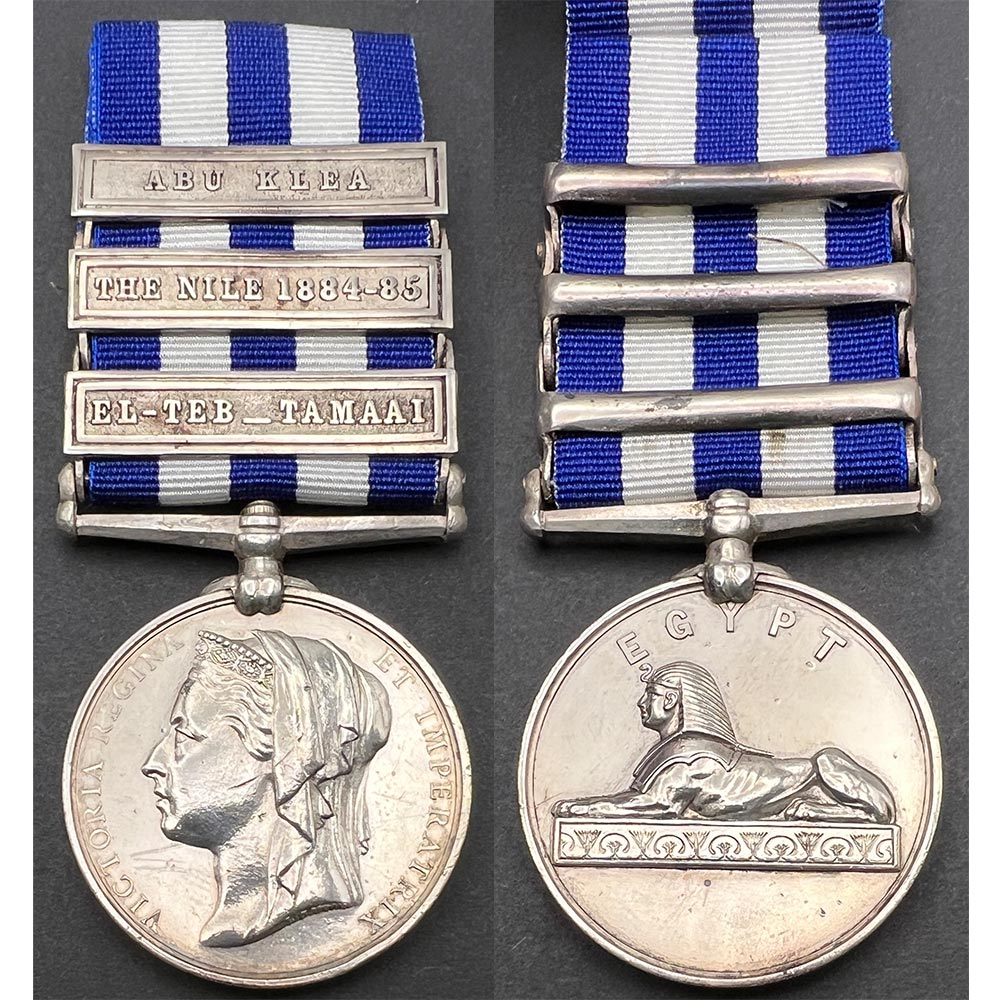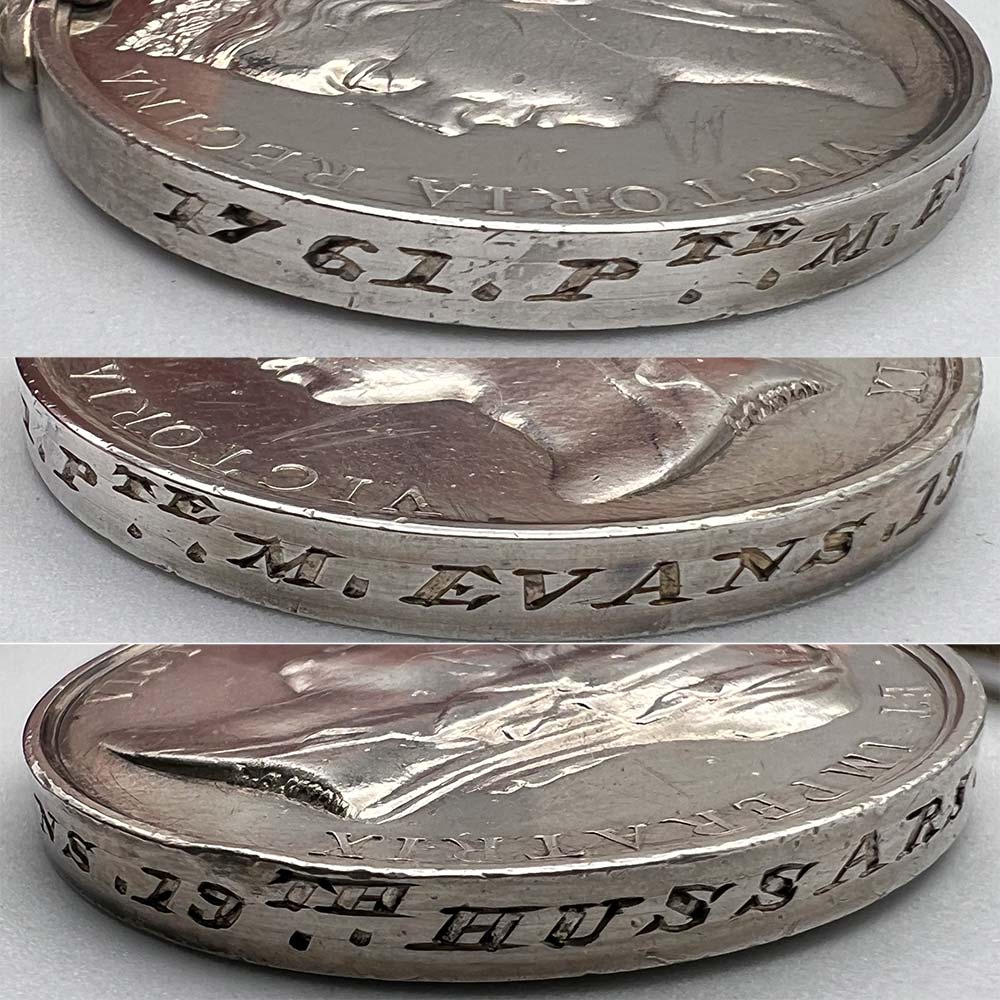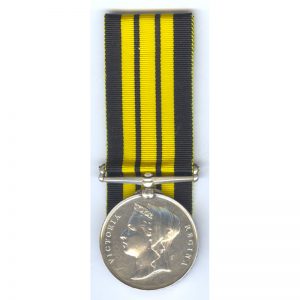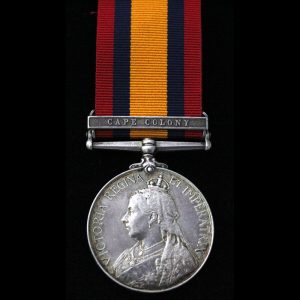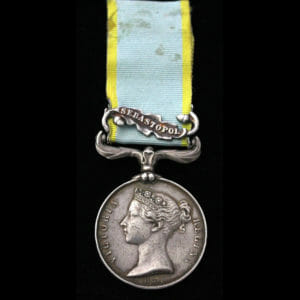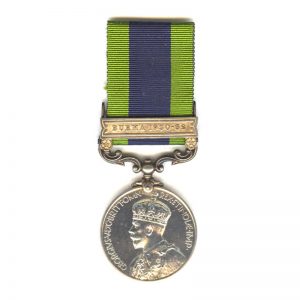Description
Egypt Medal, 3 bars, El Teb Tamaai, The Nile 1884-5, Abu Klea, 1761 Private Michael Evans, 19th Hussars.
“There is no braver men than the Arabs of the Soudan. Armed with sword and spear, in spite of hundreds being shot down, many of them succeeded in coming hand to hand with their foes and the matter was decided by the Bayonet.” – John Biddulph writes regarding the battle of El-Teb in his history of the 19th Hussars
Officially engraved: “1761 Pte. M. Evans. 19th Hussars.”
Confirmed on the medal roll, rare combination.
Particularly good condition, barely any star pitting and little overall likely due to his “dishonourable discharge” around the time of the issue of the medal.
Private Michael Evans of the Queen Alexandra’s Own 19th Royal Hussars was born in Dublin, Ireland, in the parish of “St Michael’s” circa 1859, from a Roman Catholic family.
He first attested for service with the 19th Hussars on 21st March 1878 aged 19 and 6 months, having worked as a Porter.
Upon arrival back home he was transferred over to the Army Reserve to finish out his term of engagement, however this would end early on 13th June 1889 as he was discharged due to “Conviction by Civil Powers of Felony” at Canterbury.
His intended place of residence was noted as back home at 80 Upper Dorset Street in the city centre of Dublin, however it notes in brackets that this might take a while as he was “At present in Prison”.
It was noted on discharge that he had numerous bad marks against his name, with 20 entries in the regimental defaulters books, alongside 1 Court Martial and 1 Conviction by Civil Powers, not including his later civil conviction this one occurring in March 1882.
He saw the following postings:
Home, 22nd March 1879 – 23rd February 1883
Egypt, 24th February 1883 – 29th April 1886
Home, 30th April 1886 – 5th May 1886, with Army Reserve until discharge in 1889.
A brief look in the Irish records following this date records an 1859 born Michael Evans, who spent some time in Mountjoy Prison for stealing during 1904 and was admitted to the Dublin Workhouse in 1918, before he died in “Dublin South” during 1919.
During the Egyptian War, Private Evans would take part in 3 difficult battles, 2 would earn him the joint clasp of “El-Teb_Tamaai” for his services in the Suakin Campaign of 1884, followed by his service in the Camel Corps during the Battle of Abu Klea as they went “Up the Nile”.
ACCOUNT OF THE BATTLE OF EL TEB
At the Battle of El-Teb and Tamaai, the 19th Hussars rode alongside the 10th Hussars as the only Cavalry to the Force, being a pivotal part of the battle as the Infantry became bogged down in their squares as they were attacked.
At El-Teb the 19th Hussars made a terrific cavalry charge at the enemy, following the battle QM Sergeant William Marshall, of the 19th Hussars would be decorated with the Victoria Cross for the rescue of Lieut Col Barrow of the 19th Hussars.
During the fighting the 19th Hussars suffered heavy losses taking the highest casualties of any unit present “Every single casualty was caused in hand-to-hand combat, by sword or spear.”, notably the enemy had in the defeat of General Baker “Baker Pasha” and the capture of Tokar become in possession of guns, small arms and ammunition, “which they used very effectively” during the battle.
The follow illustrative account from the regimental history of this day reads:
“The 10th Hussars, and two squadrons of the 19th under Lieutenant Colonel Barrow, charged a large body of Arabs
composed of horsemen, men on camels, and footmen, and at once became involved in a desperate hand to hand
conflict. This body of Arabs had not been engaged with our infantry, and were quite fresh. Thirty Arab horsemen
charged one of the leading squadrons, three of them getting through and wheeling their horses in pursuit regardless of the second line. The Arab swordsmen and Spear-men, taking advantage of the scrub and broken ground, hamstrung horses as they passed, and then attacked the riders. Captain Freeman of the 19th and several men were killed, and many wounded.
Of all those who lost their horses in the mêlée, Colonel Barrow alone escaped alive. His horse was killed, and he received a thrust from a spear that passed through his arm and penetrated his side. Surrounded by numbers of the enemy, he must have been killed, had it not been for the devotion of Quarter Master Sergeant William Marshall who rode to his assistance, seconded by Sergeant Fenton and Private Bosely.
Marshall gave the Colonel his hand. Running in this fashion, in rear of the charging squadrons, Barrow, with the heavy spear swaying to and fro in his side, managed to get free of the enemy before he sank down. His attendant trumpeter, in spite of sixteen terrible wounds, kept his horse going, and escaped from the press, to die of his injuries later.
Captain Jenkins, on whom the command of the two squadrons devolved, on Barrow being disabled, was engaged by three of the enemy at once. His horse was wounded in three places, but he himself escaped with a slight wound. Horsemen, as a rule, have little difficulty in dispersing and driving before them disordered infantry: but, so extraordinary was the activity and bravery of the Arabs, and the skill with which they used their spears and two-handed swords that, in the uneven ground covered with low mimosa bushes, they were more than a match for horsemen. It was not till some men had dismounted, and opened fire on them, that they sullenly drew off and retreated.”
ACCOUNT OF THE BATTLE OF TAMAAI
An account of the day from the Regimental History reads:
day, to encounter Osman Digna in person, who was encamped at Tamai, sixteen miles from Suakin.
On the night of the 12th, the whole force bivouacked in front of Osman Digna’s position; the infantry at about one mile, the cavalry four miles in rear of the infantry.
At eight the next morning, the advance commenced: the two infantry brigades in squares, the cavalry in rear of the left. The Arab skirmishers, who had pelted the British encampment with rifle fire during the night, fell back, increasing in numbers as they retired.
Seeing a great number of the enemy in front of them, massed in a ravine, the front line of the 2nd brigade charged with the bayonet, destroying the formation of their square. The active Arabs broke into the opening, stabbing and slashing at close quarters. Numbers followed and for a few minutes a catastrophe was imminent.
The cavalry galloped forward on the left, dismounted, and poured volley after volley into the flank of the advancing Arabs, while the bayonet and spear contended for victory within the square itself. The 1st brigade, which had repulsed a similar charge, swept the right face of the 2nd brigade square with its fire, and, in a few minutes, the last surviving Arab who had penetrated the square had paid the penalty. The ranks were reformed, and the infantry advance was resumed, the cavalry clearing away the numerous small parties of the enemy who still clung to the broken ground. The battle was over. In those few minutes over 2000 of the enemy had fallen, out of an estimated number of 12,000; of the British force, 109 officers and men were killed, and 112 wounded. The 19th Hussars lost one killed and two wounded.
On the following day the force advanced to Tamai, burned Osman Digna’s camp, and returned to Suakin. For a fortnight the force lay at Suakin, the cavalry and mounted infantry being employed in daily reconnaissances. On the 27th, the whole force advanced for a distance of 25 miles to ascertain if the enemy remained in any force. A few hundreds only were found. Beyond some desultory skirmishing, which drew from the General in command a highly complimentary order, nothing serious occurred, and the force returned to Suakin.
“Too high praise can scarcely be given to the Cavalry and Mounted Infantry, who bore the brunt of a long skirmish on rocky ground unsuited for cavalry action, and who, the following morning, although nearly twenty-four hours without water for their horses, performed admirable scouting duty during the advance of the force in a mountainous district, when distant peaks and ridges had to be crowned and watched.”
THE BATTLE OF ABU KLEA
A Brief account of the Battle of Abu Klea from the viewpoint of the 19th Hussars:
“Suddenly a great body of Arabs, 5000 strong, rose from a fold in the ground, and rushed at the square.
So rapid and overwhelming was their attack, aided by the inequalities of the ground, and the fact that the fire from the square was at first impeded by its own retiring skirmishers that, in spite of the heavy fire poured upon them, the Arabs succeeded in penetrating the square, as at Tamaai, stabbing and slashing in every direction.
At the same moment, a squadron of horsemen charged the square, but were repulsed.
For 5 minutes the hand to hand conflict raged, till the last Arab who had penetrated the formation was killed.
The remainder who had been heavily punished by Rifle and Artillery fire drew off, though for a time it seemed doubtful if they would not renew the attack.
The 19th, who had helped the square with dismounted fire, followed and cut off many stragglers, but the number of the enemy was too great to admit of a charge on the main body. The horses were also hardly about to move out of a walk, having been thirty hours without water. In this brief conflict the small British Force lost 74 killed, 94 wounded, some of whom died of their injuries. As at El Teb and Tamaai, the fatal skill with which the Arabs used their weapons is shown by the relative numbers of killed and wounded.
Of the Arabs, whose strength was estimated at about 9000 men, 1100 dead were counted in close proximity to the square.”
When the 19th Hussars went “Up the Nile” They had 17 Officers and 322 Other Ranks.
Out of these only 7 Officer and 128 men would be present at the Battle of Abu Klea.
The 19th Hussars were the only Cavalry Regiment present who were on Horseback instead of Camels, with the Camel Corps.
This allowed them to be particularly nimble and effective in action, they had very hardy Arabian Stallions, bought by the Egyptian Government in Syria and Lower Egypt that had lived in the desert.
Due to their Horses the 19th Hussars were tasked with all the advanced scouting as they could cover ground much quicker than the men on their Camels.
Remarkably out of 350 Horses bought for the 19th Hussars and employed in the campaign, only 12 died of disease. “The Syrian Horse has a wonderful constitution, and is admirably suited for warfare in an eastern climate.” as recalled by an officer.
A report written the day after the battle:
“The Cavalry Horses were quite done up. The way in which Barrow had managed to bring the 19th Hussars across the desert is one of the best things in the expedition; but the horses had only had a short drink at Abu Klea, and then they had barely got enough to wash their mouths out until they got to the Nile on 20th. The Scouting of the Hussars during the march was admirably done; they were ubiquitous. But want of food and water no horses can fight against, and they were a sorry spectacle as they moved out of the zeriba to go down to the river. They reached the Nile almost useless as cavalry, and could only be employed for scouting purposes, at short distances from the camp”
